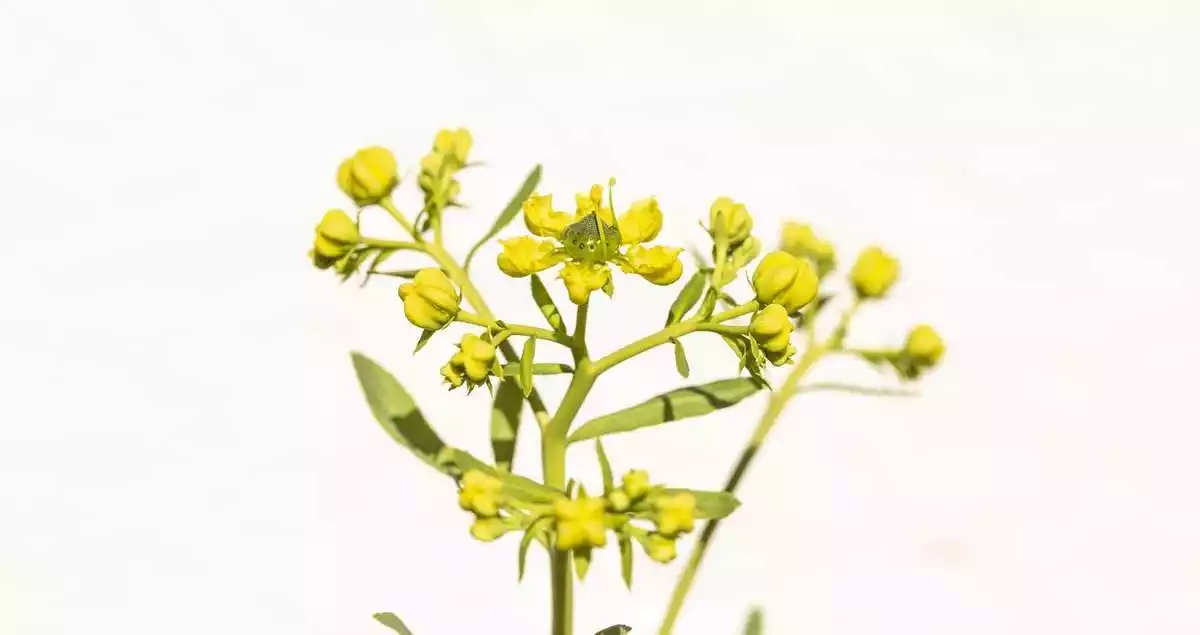
Rue plant, scientifically named, Ruta graveolens, is a medicinal plant native to Southern Europe, used as a remedy for sprains and injuries, as well as a pain reliever, and in cases of eye strain.
Below we will explain what rue plant is and how to use this herb-based on homeopathy. Besides, we describe how to prepare rue herb for use in a wide variety of natural remedies.
What is rue plant?
Ruta graveolens, commonly known as rue, is a medicinal plant often used for homeopathic remedies. This plant is also known as the herb of grace, herb of regret, or the bitter herb.
Rue plant grows to a height of approximately 1 meter and has fleshy leaves and yellow flowers. This plant is native to Southern Europe and cultivated worldwide. Rue herb has a strong and unpleasant odor.
The chemical compounds found in rue plant include rutamarin, a flavonoid; alkaloids, including graveoline and acridine; lignans in the roots; and furanocoumarins, that are compounds toxic to humans and animals.
Symptoms of rue poisoning in humansinclude nausea, vomiting, stomach pain, exhaustion, and convulsions. Animals that consume rue plant outdoors tremble, urinate frequently, have difficulty breathing, and experience a loss of coordination.
Homeopathic medicine believes that illnesses are cured by treating them with products that produce the same symptoms as the illness itself. These products follow another homeopathic law, the Law of Infinitesimals.
As opposed to in traditional medicine, the Law of Infinitesimals states that the lower the dose of the "curing" substance, the more effective it will be. The curing agent is diluted many, many times to achieve a very low dose until there is just a small amount in a large quantity of diluting liquid.
Rue plant uses and benefits
In homeopathy, rue plant is a common first aid remedy with medicinal uses. It is used to treat pulled muscles and sprains, cartilage and tendon injuries, as well as sciatica and periosteum pain. This herb is often used to relieve pain and rigidity in the hands, wrists, feet, and legs.
Likewise, this medicinal herb is a remedy for strained vision. In this case, primarily it is used when eyes are red and burning, generally after intense periods of work where eyes experience straining. Ruta graveolens is also used totreat headaches that are the result of eye strain.
In homeopathic dentistry, ruda plant is used to relieve toothaches. It is also used to treat infections in the dental alveoli after tooth extraction. Other homeopathic uses for this plant include wart treatment on the feet, rectal pain, rectal prolapse, weakness, and to treat depression.
In homeopathic medicine, if specific symptoms improve or get worse under different conditions, this is used as a diagnostic tool to decide which remedy would be the most effective. Symptoms that improve with rue plant treatment get worse with excessive eye focus, cold and humid weather, rest or lying down, and when squatting. On the other hand, these symptoms get better with movement.
Besides homeopathic uses, rue herb has been used by successful herbalists for centuries -ancient Greeks used it to get rid of coughing. During the Middle Ages, ruda herb was used in a spell against witchcraft. It was also used as an emmenagogue and for abortions, as well as a way of causing a woman to get her period. The painter Michael Angelo (1475-1564) and artists of his time, believed that rue plant would improve their vision.
Due to its strong smell, rue flower was used to avoid pest infestations, to repel flies, kill fleas, and to prevent the spread of typhus. It has also been used to treat mushroom poisoning, snake and poisonous insect bites, epilepsy, and internal parasites.
Preparing rue herb
You should use the entire rue plant for natural remedies. Pick the herb before it flowers, and then dry it. For homeopathic remedies, the dry plant material is crushed and then diluted extensively in its preparation.
There are two levels of homeopathic dilution: the decimal scale (x), with a 1:10 dilution, and the centesimal scale (c), with a 1:100 dilution. Once you dilute the mixture, you must shake, filter, and then dilute it several times again to achieve the desired strength.
Add the final mix to tablets or lactose granules (a type of sugar) and then store it in a dark place. Otherwise, you can purchase rue plant in pill form, and the dosage depends on the symptoms that you want to treat.
In homeopathy, the dilution of the medicinal components for the dose used to cure is so intense, that few molecules of the original remedy remain in the final product. However, homeopaths believe that these remedies continue to work through an effect known as "dynamization" that still has yet to be explained by conventional scientists.
Rue plant precautions and side-effects
Pregnant women should not use this plant since it stimulates uterine contractions and could provoke a simultaneous abortion -which explains why it was used in abortions historically.
After touching fresh rue flower, many people experience contact dermatitis (a rash). For this reason, it is important to use gloves when harvesting this plant, to prevent these rashes.
When consumed in its diluted version, as recommended, side-effects should not be experienced, except for in individual cases as occurs with many homeopathic remedies. Likewise, take note that rue herb causes negative interactions with warfarin sodium, an anticoagulant (blood thinner) drug.
References
Davidson, T., & Frey, R. J. (2005). Ruta. In J. L. Longe (Ed.), The Gale Encyclopedia of Alternative Medicine (2nd ed., Vol. 3, pp. 1769-1771). Detroit: Gale.
More posts:
